NVIDIA GeForce GTX 690 Review: Ultra Expensive, Ultra Rare, Ultra Fast
by Ryan Smith on May 3, 2012 9:00 AM ESTPower, Temperature, & Noise
As always, we’re wrapping up our look at a video card’s stock performance with a look at power, temperature, and noise. More so than even single GPU cards, this is perhaps the most important set of metrics for a multi-GPU card. Poor cooling that results in high temperatures or ridiculous levels of noise can quickly sink a multi-GPU card’s chances. Ultimately with a fixed power budget of 300W or 375W, the name of the game is dissipating that heat as quietly as you can without endangering the GPUs.
| GeForce GTX 600 Series Voltages | ||||
| Ref GTX 690 Boost Load | Ref GTX 680 Boost Load | Ref GTX 690 Idle | ||
| 1.175v | 1.175v | 0.987v | ||
It’s interesting to note that the GPU voltages on GTX 680 and GTX 690 are identical; both idle at the 0.987v, and both max out at 1.175v for the top boost bin. It would appear that NVIDIA’s binning process for the GTX 690 is looking almost exclusively at leakage; they don’t need to find chips that operate at a lower voltage, they merely need chips that don’t waste too much power.
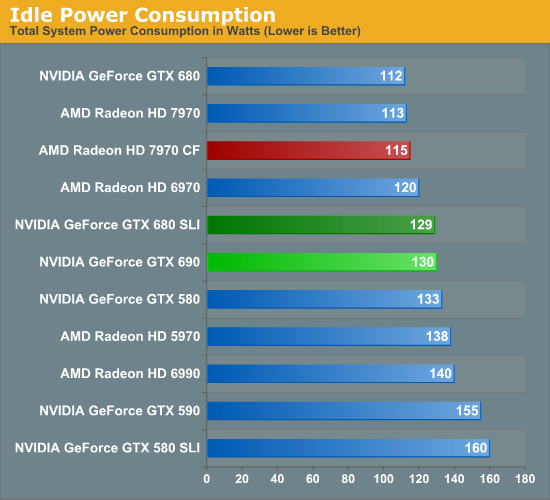
NVIDIA has progressively brought down their idle power consumption and it shows. Where the GTX 590 would draw 155W at the wall at idle, we’re drawing 130W with the GTX 690. For a single GPU NVIDIA’s idle power consumption is every bit as good as AMD’s, however they don’t have any way of shutting off the 2nd GPU like AMD does, meaning that the GTX 690 still draws more power at idle than the 7970CF. Being able to shut off that 2nd GPU really mitigates one of the few remaining disadvantages of a dual-GPU card, and it’s a shame NVIDIA doesn’t have something like this.
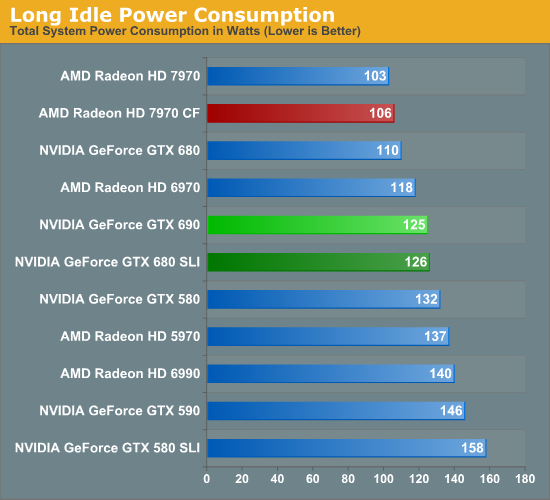
Long idle power consumption merely amplifies this difference. Now NVIDIA is running 2 GPUs while AMD is running 0, which means the GTX 690 is leading to us pulling 19W more at the wall while doing absolutely nothing.
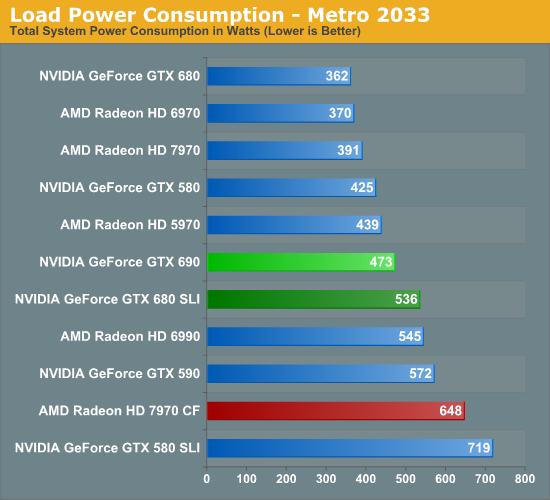
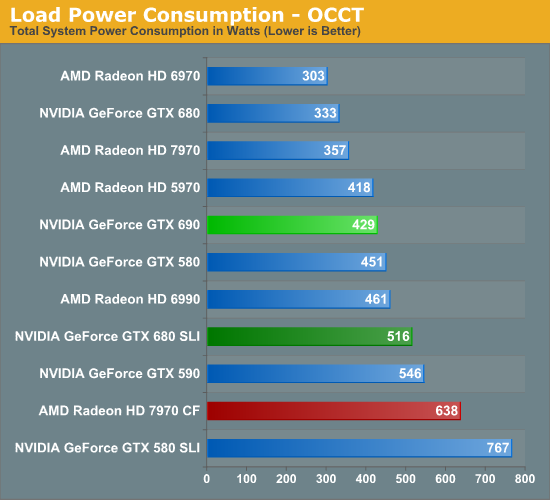
Thanks to NVIDIA’s binning, the load power consumption of the GTX 690 looks very good here. Under Metro we’re drawing 63W less at the wall compared to the GTX 680 SLI, even though we’ve already established that performance is within 5%. The gap with the 7970CF is even larger; the 7970CF may have a performance advantage, but it comes at a cost of 175W more at the wall.
OCCT power is much the same story. Here we’re drawing 429W at the wall, an incredible 87W less than the GTX 680 SLI. In fact a GTX 690 draws less power than a single GTX 580. That is perhaps the single most impressive statistic you’ll see today. Meanwhile compared to the 7970CF the difference at the wall is 209W. The true strength of multi-GPU cards is their power consumption relative to multiple cards, and thanks to NVIDIA’s ability to get the GTX 690 so very close to the GTX 680 SLI the GTX 690 is absolutely sublime here.
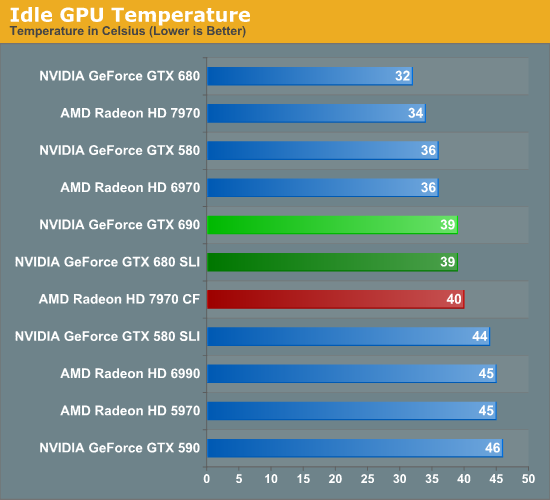
Moving on to temperatures, how well does the GTX 690 do? Quite well. Like all dual-GPU cards GPU temperatures aren’t as good as with single-GPU cards, but it’s also no worse than any dual-GPU setup. In fact of all the dual-GPU cards in our benchmark selection this is the coolest, beating even the GTX 590. Kepler’s low power consumption really pays off here.
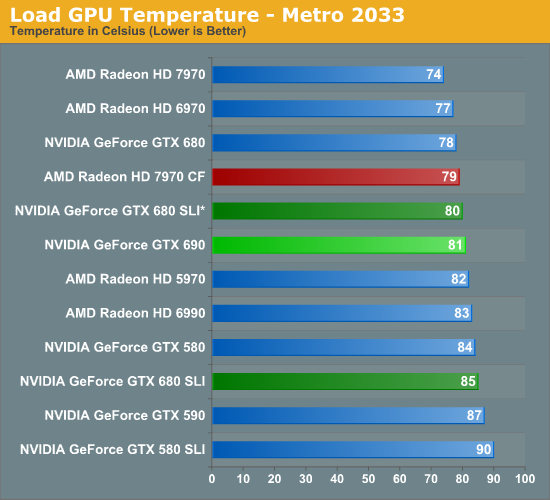

For load temperatures we’re going to split things up a bit. While our official testing protocol is to test with our video cards directly next to each other when doing multi-card configurations, we’ve gone ahead and tested the GTX 680 SLI both in an adjacent and spaced configuration, with the spaced configuration marked with a *.
When it comes to load temperatures the GTX 690 once again does well for itself. Under Metro it’s warmer than most single GPU cards, but only barely so. The difference from a GTX 680 is only 3C, 1C with a spaced GTX 680 SLI, and it’s 4C cooler than an adjacent GTX 680 SLI setup. More importantly perhaps is that Metro temperatures are 6C cooler than on the GTX 590.
As for OCCT, the numbers are different but the story is the same. The GTX 690 is 3C warmer than the GTX 680, 1C warmer than a spaced GTX 680 SLI, and 4C cooler than an adjacent GTX 680 SLI. Meanwhile temperatures are now 8C cooler than the GTX 590 and even 6C cooler than the GTX 580.
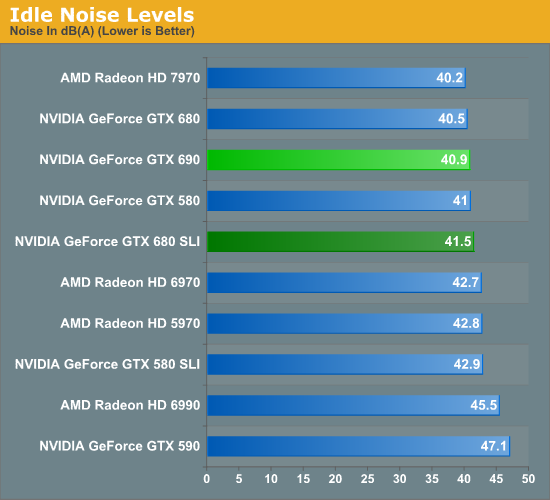
So the GTX 680 does well with power consumption and temperatures, but is there a noise tradeoff? At idle the answer is no; at 40.9dB it’s effectively as quiet as the GTX 680 and incredibly enough over 6dB quieter than the GTX 590. NVIDA’s progress at idle continues to impress, even if they can’t shut off the second GPU.


When NVIDIA was briefing us on the GTX 690 they said that the card would be notably quieter than even a GTX 680 SLI, which is quite the claim given how quiet the GTX 680 SLI really is. So out of all the tests we have run, this is perhaps the result we’ve been the most eager to get to. The results are simply amazing. The GTX 690 is quieter than a GTX 680 SLI alright; it’s quieter than a GTX 680 SLI whether the cards are adjacent or spaced. The difference with spaced cards is only 0.5dB under Metro, but it’s still a difference. Meanwhile with that 55.1dB noise level the GTX 690 is doing well against a number of other cards here, effectively tying the 7970 and beating out every other multi-GPU configuration on the board.
OCCT is even more impressive, thanks to a combination of design and the fact that NVIDIA’s power target system effectively serves as a throttle for OCCT. 55.8dB is not only just a hair louder than under Metro, but it’s still a hair quieter than a spaced GTX 680 SLI setup. It’s also quieter than a 7970, a GTX 580, and every other multi-GPU configuration we’ve tested. The only thing it’s not quieter than is the GTX 680 and the 6970.
With all things considered the GTX 690 is not that much quieter than the GTX 590 under gaming loads, but NVIDIA has improved performance just enough that they can beat their own single-GPU cards in SLI. And at the same time the GTX 690 consumes significantly less power for what amounts to a temperature tradeoff of only a couple of degrees. The fact that the GTX 690 can’t quite reach the GTX 680 SLI’s performance may have been disappointing thus far, but after looking at our power, temperature, and noise data it’s a massive improvement on the GTX 680 SLI for what amounts to a very small gaming performance difference.










200 Comments
View All Comments
james.jwb - Thursday, May 3, 2012 - link
You are correct, I don't own one... I own three in triple screen. Dell U2412m's.I really am at a loss as to what you are on about. It is well known that 16:10 is preferred amongst enthusiasts and professionals for a few reasons. If you want 16:9, fine, go for it, but don't act like it's weird that AT are benching with 16:10 just because you went with cheap ass 16:9 screens.
CeriseCogburn - Friday, May 4, 2012 - link
Yes of course you are at a loss, you don't understand a word so why reply ?You're all at a loss.
ROFL
yelnatsch517 - Friday, May 4, 2012 - link
Are you being sarcastic or an idiot?From my experience 1900x1200 24" monitors are the MAJORITY. My work has roughly 50 24" monitors all in that resolution. My HP ZR24W is 1900x1200 as well. The only 24" monitor that I have even seen is the TN panel that came with an HP computer.
If you are talking about computer monitors, 1900x1200 is the dominant resolution. If you are talking about TVs, then obviously 1080p is the norm.
CeriseCogburn - Saturday, May 5, 2012 - link
There are 242 - count them, well over 200, nearly 250 1920X1080 monitors at the egg._
In your great experience, there are 16 that fit your 1920X1200 dreampipe FUD scenario at the egg, with most of them, well over half, over $400 each, while the 242 common monitors you all buy as you pinch every penny and whine about $10 difference in videocard prices are well under $200 each a lot of the time.
So now suddenly, you all spend way over $300 to plus $400 for 11% more pixels... ROFL HAHAHHAHHA instead of $150 or $200...
I guess that's why this place is so biased, the little bloggers are just as whacked when it comes to being honest.
InsaneScientist - Saturday, May 5, 2012 - link
Good grief... resorting to personal attacks isn't exactly a good way to get people to listen to you.I'm not going to argue that 1080p isn't more common (from what I've read, no one is), because it is more common, you are quite correct there, however I must point out that your logic to arrive at that conclusion is faulty:
You're contending that 1080p is more common (it is) because there are more models available on Newegg, but just knowing how many models are available doesn't tell us how many units those move.
If, for example, each of those 22 models of 1920x1200 monitors moves 10 times as much stock as each of the 1920x1080, nearly as many of the 1920x1200 will have been sold as the 1920x1080 ones.
Now, I don't think that's likely, and I do agree with you that 1080p is more common nowadays (see next point), but your argument is invalid, even though you have come to the correct conclusion.
Consider this: there are currently two models of iPhone available, compared to dozens of Android phones. By the same logic as you're using, I could say that the iPhone is incredibly rare - I'd get laughed out of town if I tried to make that argument.
The second point is that 1920x1200 hasn't been nearly as rare in the past as it is today. When I bought my previous monitor and my laptop (both 1920x1200), 1080p monitors were almost unheard of. Since monitors tend to last a while, it's not at all unreasonable for a disproportionate amount of people to be using them compared to their current sales.
Thirdly, there is a point of diminishing returns. Notice the complete lack of any benchmarks at or below 1680x1050? These cards are so fast that comparisons at those resolutions are pointless - they're all fast enough for anything you could do to them at that screen res - even Crysis. 1920x1080 almost falls into that category, heck, even 1920x1200 almost falls into that category. Benchmarks are only about who wins if there is some advantage to winning. Below 2560x1600, which card you're using is almost completely irrelevant, so why does it even matter whether they used 1920x1080 or 1920x1200?
CeriseCogburn - Tuesday, May 8, 2012 - link
Blah blah blah blah and I'm still 100% correct and you are not at all.Decembermouse - Tuesday, May 8, 2012 - link
You're quite a character.anirudhs - Thursday, May 3, 2012 - link
I use 2 at work - HP ZR24W.piroroadkill - Sunday, May 6, 2012 - link
Hm, odd.Not only do I have 1920x1200 monitor on my desktop, I have TWO laptops with 1920x1200 screens. Using one right now.
Yes, they're rarer than 1080p screens, but this is a site for enthusiasts, therefore, it is more likely.
Ryan Smith - Thursday, May 3, 2012 - link
The truth is a bit more simple than that. 5760x1200 is because our choice in monitors for multi-monitor testing was based on my personal monitor, which is another PA246Q. NVIDIA's limited display flexibility (same res + same sync) meant that it was easiest to just pair the PA246Q with some more PA246Qs, Consequently it's easier to just test these monitors at their native resolution when we're using NVIDIA cards.